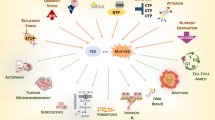Abstract
The candidate tumour-suppressor gene ING1 has been identified by using the genetic suppressor element (GSE) methodology1. ING1 encodes a nuclear protein, p33ING1, overexpression of which inhibits growth of different cell lines. The properties of p33ING1suggest its involvement in the negative regulation of cell proliferation and in the control of cellular ageing, anchorage dependence and apoptosis1,2,3. These cellular functions depend largely on the activity of p53, a tumour-suppressor gene that determines the cellular response to various types of stress4. Here we report that the biological effects of ING1 and p53 are interrelated and require the activity of both genes: neither of the two genes can, on its own, cause growth inhibition when the other one is suppressed. Furthermore, activation of transcription from the p21/WAF1 promoter, a key mechanism of p53-mediated growth control, depends on the expression of ING1. A physical association between p33ING1and p53 proteins has been detected by immunoprecipitation. These results indicate that p33ING1is a component of the p53 signalling pathway that cooperates with p53 in the negative regulation of cell proliferation by modulating p53-dependent transcriptional activation.
This is a preview of subscription content, access via your institution
Access options
Subscribe to this journal
Receive 51 print issues and online access
$199.00 per year
only $3.90 per issue
Buy this article
- Purchase on Springer Link
- Instant access to full article PDF
Prices may be subject to local taxes which are calculated during checkout




Similar content being viewed by others
References
Garkavtsev, I. A., Kazarov, A. R., Gudkov, A. V. & Riabowol, K. Suppression of the novel growth inhibitor p33ING1 promotes neoplastic transformation. Nature Genet. 14, 415–420 (1996).
Garkavtsev, I. & Riabowol, K. Extension of the replicative life span of human diploid fibroblasts by inhibition of the p33ING1 candidate tumor suppressor. Mol. Cell. Biol. 17, 2014–2019 (1997).
Helbing, C. C., Veillette, C., Riabowol, K., Johnston, R. N. & Garkavtsev, I. Anovel candidate tumor suppressor, ING1, is involved in the regulation of apoptosis. Cancer Res. 57, 1255–1258 (1997).
Gottlieb, T. M. & Oren, M. p53 in growth control and neoplasia. Biochim. Biophys. Acta 1287, 77–102 (1996).
Garkavtsev, I., Demetrick, D. & Riabowol, K. Cellular localization and chromosome mapping of a novel candidate tumor suppressor gene. Cytogenet. Cell Genet. 76, 176–178 (1997).
Zeremski, M., Horrigan, S., Grigorian, I. A., Westbrook, C. & Gudkov, A. V. Chromosomal localization of p33 ING1 candidate tumor suppressor gene. Somat. Cell Mol. Genet. 23, 233–236 (1997).
Maestro, R. et al. Chromosome 13q deletion mapping in head and neck squamous cell carcinomas: identification of two distinct regions of preferential loss. Cancer Res. 56, 1146–1150 (1996).
Ossovskaya, V. S. et al. Dissection of p53 functions by genetic suppressor elements: distinct biological effects of separate p53 domains. Proc. Natl Acad. Sci. USA 93, 10309–10314 (1996).
El-Deiry, W. S. et al. WAF-1, a potential mediator of p53 tumor suppression. Cell 75, 817–825 (1993).
Kondratov, R. V. et al. Functional heterogeneity of p53-responsive elements. Mol. Biol. (Mosk.) 30, 613–620 (1996).
Momand, J., Zambetti, G. P., Olson, D. C., George, D. & Levine, A. J. The mdm-2 oncogene product forms a complex with the p53 protein and inhibits p53 mediated transactivation. Cell 69, 1237–1245 (1992).
Jayaraman, L. et al. Identification of redox/repair protein Ref-1 as a potent activator of p53. Genes Dev. 11, 558–570 (1997).
Avantaggiati, M. L. et al. Recruitment of p300/CBP in p53-dependent signal pathway. Cell 89, 1175–1184 (1997).
Kopnin, B. P. et al. Influence of exogenous ras and p53 on P-glycoprotein function in immortalized rodent fibroblasts. Oncol. Res. 7, 299–306 (1995).
Pear, W. S., Nolan, G. P., Scott, M. L. & Baltimore, D. Production of high-titer helper-free retroviruses by transient transfection. Proc. Natl Acad. Sci. USA 90, 8392–8396 (1993).
Harvey, D. M. & Levine, A. J. p53 alteration is a common event in the sponaneous immortalization of primary BALB/c murine embryo fibroblasts. Genes Dev. 5, 2375–2385 (1991).
Agarwal, M. L., Agarwal, A., Taylor, W. R. & Stark, G. R. p53 controls both the G2/M and the G1 cell cycle checkpoints and mediates reversible growth arrest in human fibroblasts. Proc. Natl Acad. Sci. USA 92, 8493–8497 (1995).
Pauwels, R. et al. Rapid and automated tetrazolium-based colorimetric assay for the detection of anti-HIV compounds. J. Virol. Methods 20, 309–321 (1988).
Acknowledgements
We thank R. Davidson and E. Feinstein for reading the manuscript, and C. Zelnick for help with manuscript preparation. This work was supported by NIH grants to A.V.G., by a Fogarty International Collaboration Award to A.V.G. and P.M.C., and fellowships from NCI to I.A.G. and V.S.O.
Author information
Authors and Affiliations
Corresponding author
Rights and permissions
About this article
Cite this article
Garkavtsev, I., Grigorian, I., Ossovskaya, V. et al. The candidate tumour suppressor p33ING1cooperates with p53 in cell growth control. Nature 391, 295–298 (1998). https://doi.org/10.1038/34675
Received:
Accepted:
Issue Date:
DOI: https://doi.org/10.1038/34675
This article is cited by
-
Analysis of patients with colorectal cancer shows a specific increase in serum anti-ING1 autoantibody levels
BMC Cancer (2023)
-
Molecular mechanisms of inhibitor of growth (ING) family members in health and malignancy
Cancer Cell International (2022)
-
Integrative epigenomic and high-throughput functional enhancer profiling reveals determinants of enhancer heterogeneity in gastric cancer
Genome Medicine (2021)
-
p33ING1b regulates acetylation of p53 in oral squamous cell carcinoma via SIR2
Cancer Cell International (2020)
-
ING5 activity in self-renewal of glioblastoma stem cells via calcium and follicle stimulating hormone pathways
Oncogene (2018)
Comments
By submitting a comment you agree to abide by our Terms and Community Guidelines. If you find something abusive or that does not comply with our terms or guidelines please flag it as inappropriate.



